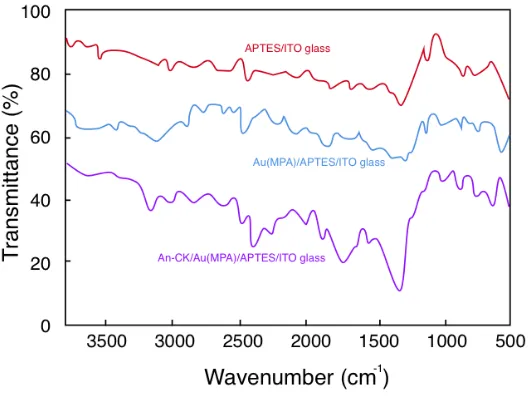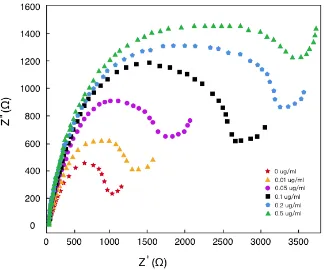Creatine Kinase Determination Based on an Electrochemical Impedance Immunosensor
Full text
Figure


![Figure 3. Nyquist plots determined for the original ITO glass plate; APTES/ITO-glass; Au(MPA)/APTES/ITO-glass; Au/APTES/ITO-glass and Ab-CK/Au(MPA)/APTES/ITO-glass in 2 mM [Fe(CN)6]3−/4− with 0.1 M KCl (voltage: 0.05 V; Frequency range: 1 Hz - 100 kHz.)](https://thumb-us.123doks.com/thumbv2/123dok_us/1820102.137634/8.596.208.371.276.433/figure-nyquist-determined-original-aptes-aptes-voltage-frequency.webp)

Related documents
electrochemical test obtained by the Tafel polarization curves in the corrosion erosion test show the good performance that generate the multilayers, due to the
The results of this study have shown that the electrochemical oxidation of oximes (HI-6, K048 and TMB-4) on a glassy-carbon electrode, which corresponds to oxidation of
Incidental entrap- ments in inshore fishing gear during 1988: Report to the Newfoundland and Labrador Department of Fisheries and Oceans Canada—Newfoundland Region and the
However, mean annual discharge did not show a trend in any of the catchments whereas annual wet N deposition showed a significant decrease only in Birkenes (1973–2003; Mann-
Rb-Sr isochron age of early proterozoic granites from Wangtu Gneissic Complex, Kinnaur Himalaya.. NewU-Pb Proterozoic datafromChor-Wailgtu granitoids of Himalayan crystalline
The Community is uniquely well placed to take the lead in joint activities carried out at the least cost for each participating Member State (e.g. nuclear safety,
One possible alternative explanation for the empirical results is that every member of the society has a preference for better material outcomes for ingroup members, however
Table 1 Details the static variables used to define the rearfoot, ankle, first ray, forefoot and hallux deformities investigated, the foot kinematic variab les used to compare feet
